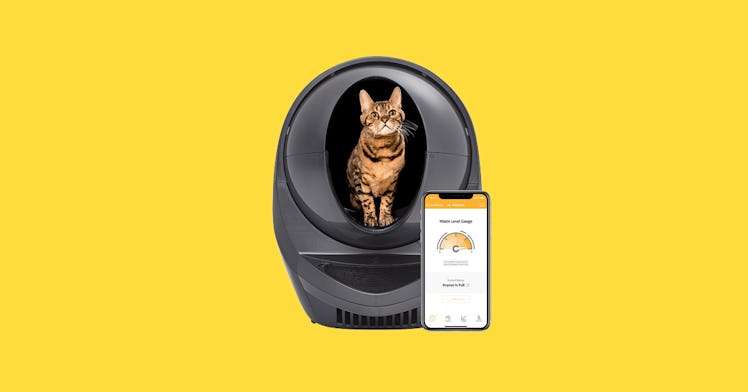The Litter-Robot Self-Cleaning Litter Box Handles the Crappiest Part of Owning a Cat
Is it a bit ridiculous? For sure. But this self-cleaning litter box takes the crap out of cat ownership.

Cats are, by and large, low-maintenance pets. They like to sleep and require minimal attention, and only when they permit it. One of the only downsides of cat ownership, of course, is that they poop once — and pee several times — a day and owners must scoop the nose hair-burning excrement out of the litter box at least once a day. If owners don’t, they can expect to find little brown chunks scattered in all corners of their home from disgruntled felines displeased with their filthy toilets as well as the eye-watering scent of ammonia. For anyone who doesn’t really enjoy the task of sifting poop from sandy litter, might I suggest investing in the self-cleaning Litter-Robot 3 Connect Self-Cleaning Litter Box. A fully automated self-cleaning litter box, it senses when the cat has gone to the bathroom and cycles the litter accordingly.
The Litter-Robot is a dome-shaped vessel that sort of looks like the back of a cement truck, were it re-imagined by Ridley Scott. It measures about 25-inches across, 30 inches high, and 27-inches deep. It has a step that’s seven inches off the ground and an entry way that’s about 10 inches wide so nearly every cat can enter it with ease. Its power comes from a 15-volt DC plug so it can work its magic. Because we live in the year 2020, it also connects to an app that allows you to monitor its every cycle.
So how does the Litter-Robot work its magic? Once a cat does its business, internal sensors register the (bowel) movement. After the cat exits (yep, it senses that too) the system waits for the litter to clump and then proceeds to rotate, sift, and distribute the excrement. The nasty bits go into a bottom drawer that’s carbon-filtered and tightly shut to prevent odor from escaping; clean litter cycles back to the top. All you have to do is empty that drawer and add more litter when the Litter-Robot alerts you that its time.
The Litter-Robot uses clumping cat litter and comes fully assembled; you just pop the hood onto the base and you’re in business. Speaking of business, cats may be wary at first. It is, after all, a bathroom that moves on its own. Mine, however, went right now, dropped a load, and never looked back.
While it might seem unnecessary, the WiFi-connectivity and app control is pretty useful. You download and connect to the app, and when you’re away you can see view just how clean the litter box is, how often litter has been cycled through, and whether it’s time for another cycle. This means that if you have kids and thus, cat comfort isn’t top of mind because you need to feed and bathe actual humans, things are taken care of for you. Same goes for if you want to get of town for the weekend and want to make sure that your cat’s personal bathroom is well kept.
The Litter-Robot is also great if you have a dog who considers cat turds the ultimate amuse bouche (been there, don’t recommend it). The way this thing is built, your dog would have to be a yoga aficionado to be able to actually get any chunks into its mouth. But chances are low it would ever be an option, because this thing makes shit disappear. Quite literally.
Waste disposal is pretty effortless. I use a garbage bag inside the drawer, but you can also opt to go without if you’re feeling brave (that carbon filter is supposed to work its magic). With my two cats, I generally have to empty it out once a week. That’s pretty great considering my former once-a-day routine.
Now, is the Litter-Robot for everyone. No. It’s a luxury, to be sure. This thing is big and this thing is pricey. But it makes my life as a pet owner that much easier. And if you’re tired of scooping litter and want that task off your incredibly long to-do list, it’s a pretty solid investment.
Every product on Fatherly is independently selected by our editors, writers, and experts. If you click a link on our site and buy something, we may earn an affiliate commission.
This article was originally published on